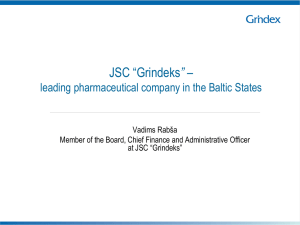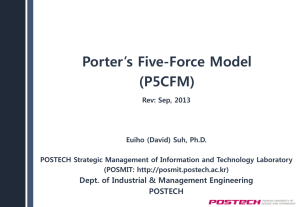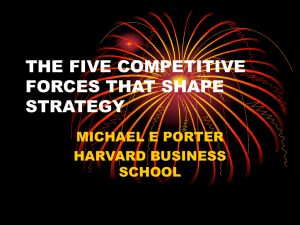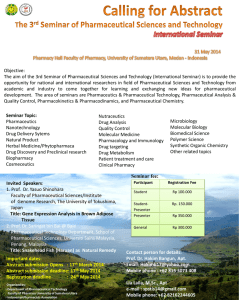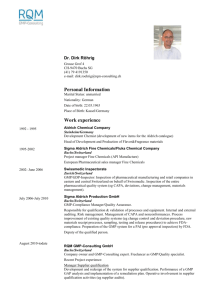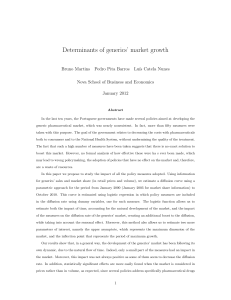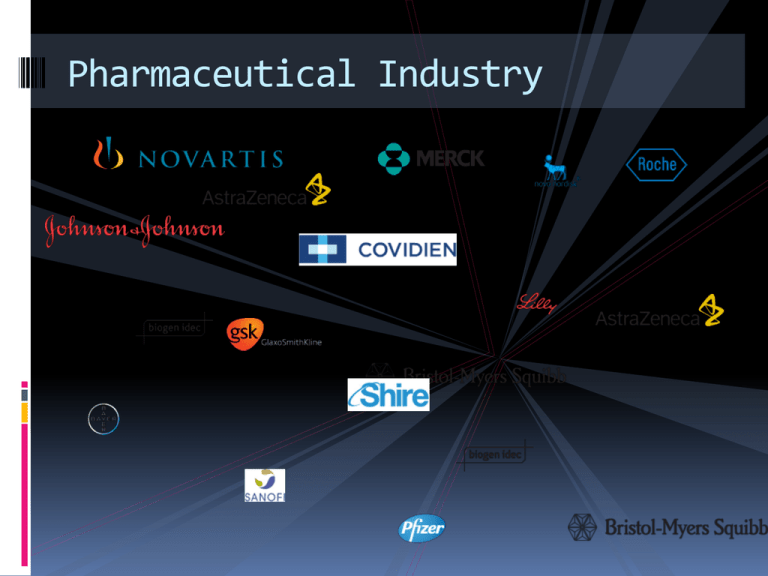
Pharmaceutical Industry
The Global pharmaceutical
industry-part-2
The Framework of five forces.
Implication of the five forces
Potentials entrants “Treat of entry”
Barriers to entry are the
factors that need to be
overcome by new
entrants if they are to
compete in industry.
Typical barriers are as
follows .
Scale and experience
In some industries, economies of scale are
extremely important. Once incumbents “existing
competitors” have reached large-scale
production, it will be very expensive for new
entrants to match them and until they reach a
similar volume they will have higher unit costs.
This scale effect is increased where there are
high investment requirements. For example in
pharmaceuticals for a new entrants it will be
high-cost investment to reach a similar volume
of large-scale production of their competitors.
Experience curve
The experience curve effects that give
incumbents “the existing competitors” a cost
advantage because they have learned how to
do things more efficiently than an
inexperienced new entrant could possibly do.
Until the new entrant has built up equivalent
experience over time it will tend to produce at
higher costs. In this case the new entrant of
pharmaceutical industries have to produce
the drugs in a higher cost.
Access to supply or
distribution channels
In many industries manufacturers have had control
over supply and/or distribution channels.
Sometimes this has been through direct ownership
“vertical integration” sometimes just through
customer or supplier loyalty. In this industry, the
countries with supply side controls negotiating price or
reimbursement approval can take as long as a year. In
those with demand-side controls there are delay in
market penetration while negotiating endorsement
by bodies such as the National Institute for clinical
Excellence (NICE) in the UK, The impact of NICE
decision on cost-effectiveness reverberates well
beyond the UK , as countries have began to
collaborate internationally in their value assessment
Expected Retaliation
In an organisation considering entering an
industry believes that the retaliation of an
existing firm will be so great as to prevent entry,
or mean that entry would be too costly, this is
also a barrier. Retaliation could take the form of
a price war or a marketing blitz. Just the
knowledge that incumbents are prepared to
retaliate is often sufficiently discouraging to act
as a barrier. For examples, in pharmaceutical
industry the existing companies maybe cant
start price war to because of the tight regulation
but the existing companies can use their power
for more R&D
The power of suppliers
Supplier are those who supply the
organisation with what it needs to produce
the product or service. As well as fuel raw
materials, and equipment, this can include
labour and sources of finance. The factor
increasing supplier power are the converse to
those for buyer power.
Control on suppliers, Mixed effect, controls to influence demand
Control on suppliers
Negotiated prices
Average Pricing
Reference Prising
Positive and negative lists
Constraints on wholesalers
Mixed effect
controls to influence demand
Partial reimbursement at price
Patient co payment
negotiated with manufacturer
Treatment guidelines
Indicative or fixed budgets
Generic substitution
Incentives to prescribe or
dispense generics or or parallel imports
And pharmacists.
Imposed price cuts
Transfer from prescription-only to OTC
Those supplier power is likely to
be high where there are :
Concentrated suppliers, where just a few
producers dominate supply, suppliers have
more power over buyers.
High switching cost. If its expensive or
disruptive to move from one supplier to
another, the buyer becomes relatively
dependent and correspondingly weak.
Supplier competition threat. Suppliers have
increased power where they are able to cut
out buyers acting as a middleman
Vertical integration
Most organisations have many suppliers, so it
is necessary to concentrate the analysis on
the most important ones or types. If their
power is high ,suppliers can capture all their
buyers ` own potential profit simply by raising
their price.
Bargaining power of Buyer
In the Pharmaceutical industry the buyers power
mainly associated with the large quantity buyers
example Government institutions
The institutions has considerable bargaining power
with drug companies and exerts strong
downward pressure on drug prices
The Consumer has no choice but to buy what has
been prescribed to them therefore their power is
low in the pharmaceutical industry.
The buyers are scattered and they as such does not
wield much power in the pharmaceutical pricing.
Threat of substitutes
In early years threat of substitute was low
Pharmaceutical companies compete fiercely to establish and retain
Intellectual rights only by securing a patent that can be defended against
imitators can the value of all R&D be recouped.
Patent laws prohibited companies from replicating other companies brand
name drugs .
Consumer brand loyalty provides defence against generic competition and
prolong the product life cycle
In recent years threat of substitute was high
Patent: Enforcing Global Intellectual Protection Rights is expensive
Switching to generics is one way to save costs after a drug expires
companies can make generics for less costs and no R&D is required.
Competitive Rivalry
„Competitive rivals are organisations
with similar products and services aimed
at the same customer group = direct
competitors“
Competitive Rivalry
•Highly risky and lengthy research and development (R&D)
process once you do R&D and invested in technology
platforms you won´t exit
•Stringent government regulation only few companies;
costs regulated by the government
•Generics had major impact on the industry, driving
innovation and a race to market
•There is effectively only one powerful purchaser, the
government ‚monopsony‘
•Cost structure: 25% manufacturing of goods; 16-24% R&D;
10% administration; 25% sales and marketing high fixed
costs ($1bn develop new drug)
•Top 10 generics companies account nearly half of the
global market (1990,USA)
•Biotechs: very long product development cycle, most
biotechs take years to reach profitability. 2008 revenues
of $95bn were concentrated in a tiny subgroup of highly
profitable firms
Competitive Rivalry
•OTC medicines: market was estimated at $104bn in 2008 with
the top 10 manufacturers accounting more than half of value
•Vaccines: $20bn market with 5 global players account for
over 85% market share
•Vaccine sales grew 32% p.a. 2004-207 due to HPV-vaccine
high growth rate but vaccines have higher development
success rates
•Majority of global pharmaceutical sales originate in 10 key
countries contributing over 80% of the global market
•Pharmaceutical market growth is strongly aligned with GDP
growth. USA 2008: $291bn which makes 40% of global sales
markets are undifferentiated
•USA contribution to global growth fell from over 50% to 9%
in just two years (2006-2008) fewer new products; higher
competition
•Japan 2nd largest market for pharmaceuticals ($77bn in
2008); had to face turbulences in the 1990s limited
market growth to an average below 3% from 1994-2008
Competitive Rivalry
•Annual growth rate of the European market was expected
to be constrained to 3-6% per year from 2008 to 2013
slow market growth
•Brazil, Russia, India, China, Mexico, South Korea and
Turkey were predicted to contribute almost half of market
growth from 2009 to 2013 markets are undifferentiated
•Blockbusters exacerbated the impact of patent expiries.
The Top 15 companies were projected to lose $70bn in
sales from 2009 to 2019 due to generic erosion slow
market growth
•mergers & acquisitions helped companies to stay in
competitive rivalry e.g. Sanofi Aventis
High competitive rivalry
References
Exploring Strategy
Text and cases
Gerry JOHNSON & Richard WHITTINGTON



